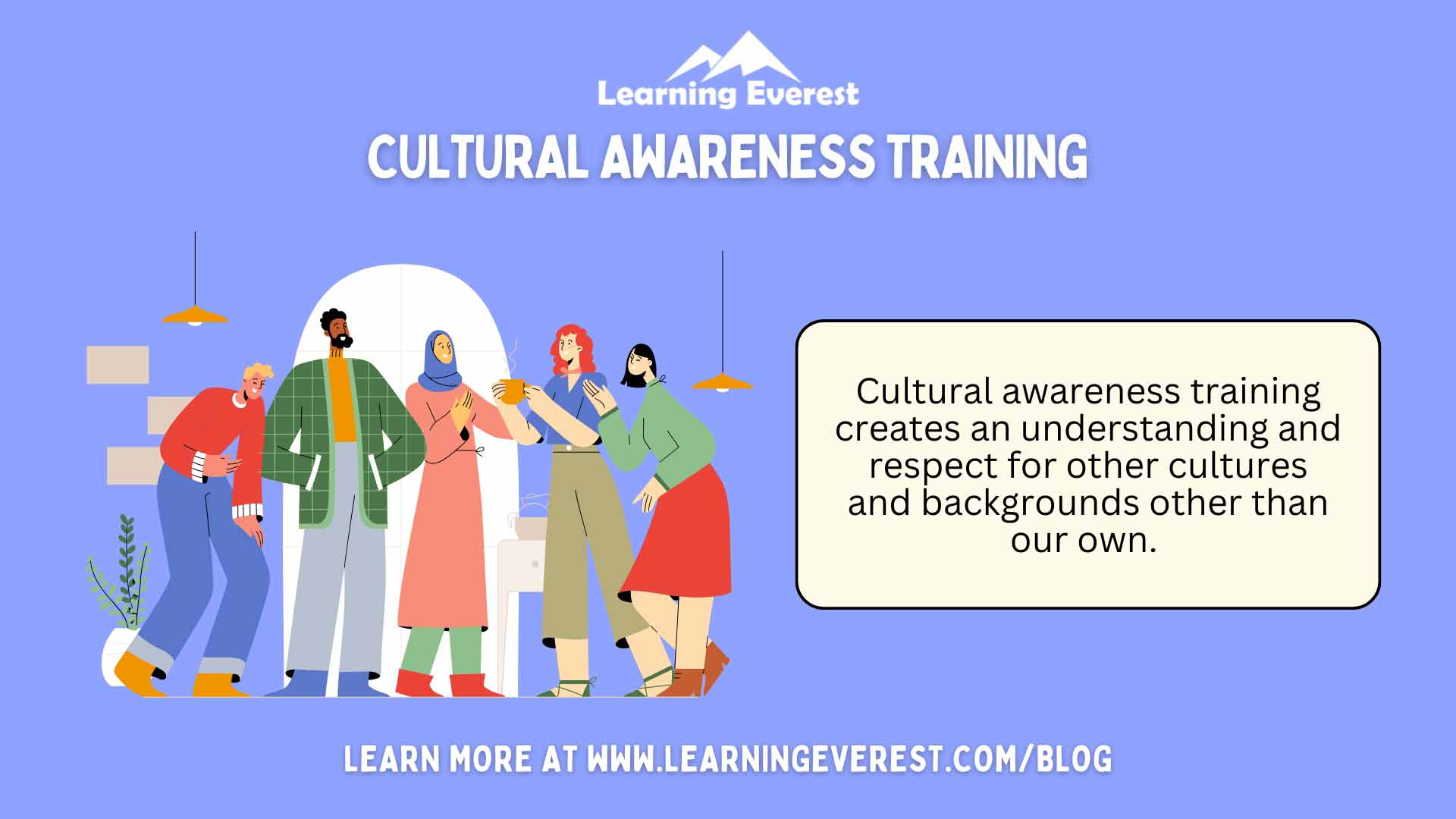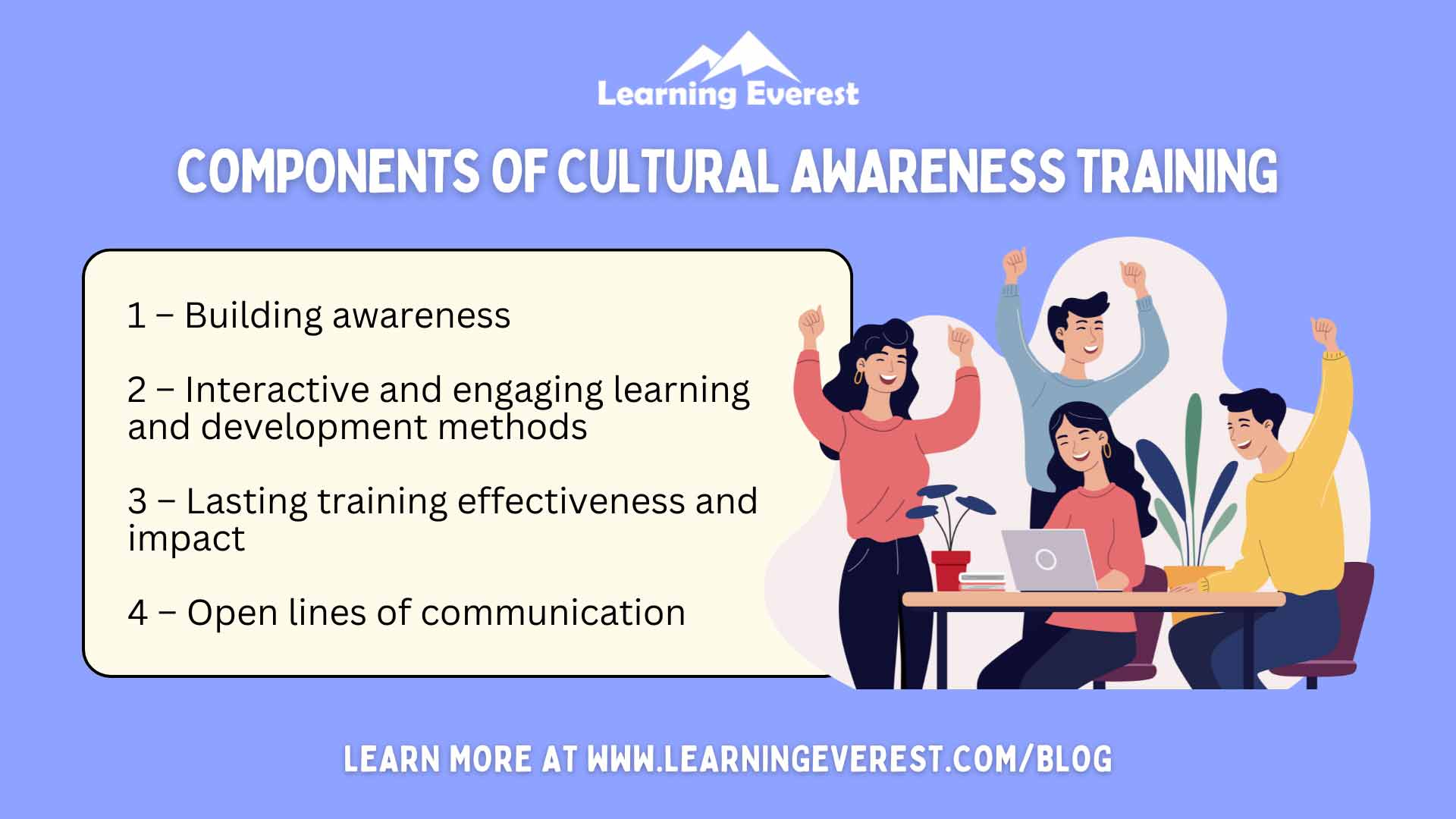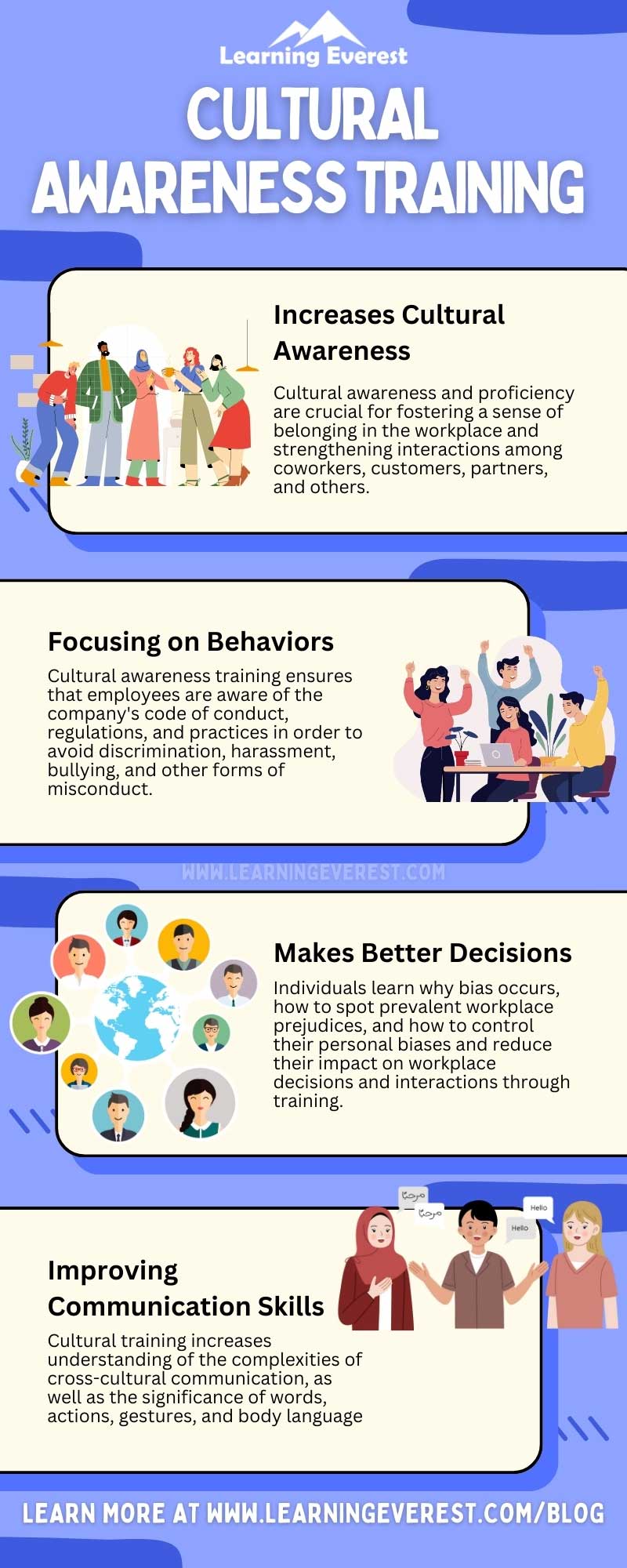What does cultural awareness training mean?
Cultural awareness training fosters understanding and respect for cultures and backgrounds other than our own. In this training, you learn how to address your own unconscious biases and how to make conscious decisions to respect others. This means acknowledging the value that each unique culture brings and not viewing your own culture as superior.

Cultural Awareness Training
For more information, read our blog on intercultural training: Definition, Elements, Benefits and Examples.
Why is Cultural Awareness Training Necessary?
A 2020 McKinsey report showed that organizations that take action to create and promote inclusive behaviors are more likely to perform financially better than other organizations surveyed.
Whether it be team members or business partners with whom an organization works, a multicultural workforce has become the norm. In general, this means that understanding the people you work with, their cultures, and the importance of diversity in the workplace is vital to an organization’s productivity and success. Cultural awareness training is designed to help individuals in global organizations build a framework for active engagement and collaboration in a diverse cultural environment. The training achieves this by increasing awareness and sensitivity to cultural differences, deepening cultural understanding, and building the necessary communication skills.
The goal of cultural awareness training is to help employees understand and adapt to different cultures in a virtual workplace where borders have largely been removed. It helps employees feel recognized and understood. It also increases empathy for coworkers, which is important for effective teamwork in international organizations.
Want to learn more about cultural intelligence? Read our blog on “What is Cultural Intelligence” to learn more.
Key Elements of Effective Cultural Awareness Training
When implemented well, cultural awareness training directly addresses employee frustration and stress that stems from an organization’s lack of sensitivity to cultural norms. Although there is no single approach to cultural awareness training, creating a successful cultural awareness training program requires attention to the following key elements:


Components of Cultural Awareness Training
Let’s discuss them in detail.
1 – Raise awareness
Cultural differences are valuable because we can learn from each other. By raising awareness, we can recognize that cultural differences exist and strive to understand different cultural behaviors and motivations. It helps us avoid cultural stereotypes and be mindful of existing cultural biases. From there, cultural awareness and understanding can help employees control their own cultural behaviors and actions, adapt to each other, clarify communications, and reduce potential conflicts.
2 – Interactive and engaging learning and development methods
For a learning program to be successful, it needs to be interactive and engaging. This also works well for cultural awareness training programs. Higher engagement in training and development programs leads to higher active participation, which is important for the effectiveness of training and learning programs. This allows employees to gain a practical understanding of how to implement cultural awareness training in the workplace. For example, role-playing exercise workshops can help navigate cultural differences as well as resolve conflicts.
3 – Lasting effects and impact of training
In some global organizations, rapid growth into a global workplace can leave employees feeling anxious and hesitant about how to navigate relationships with their new coworkers. While cultural awareness training programs primarily focus on interpersonal skills such as empathy, compassion, and adaptability, a well-rounded program should also teach other skills such as communication, leadership, and problem-solving. The tools and practices included in a well-rounded cultural awareness training program should help employees quickly adapt to a changing workforce.
4 – Open lines of communication
Learning to understand and recognize cultural differences doesn’t end with intercultural awareness training, but continues into the daily operations of the workplace. That’s why open lines of communication — two-way communication — are essential to foster continuous learning and development. By communicating respectfully and transparently, employees continue to share their knowledge with each other. By improving active listening skills, soft skills, communication issues can be resolved as they arise, helping to build an inclusive work culture where multiculturalism can thrive.
How to Design a Cultural Awareness Training Course


How to Design a Cultural Awareness Training Course
Let’s discuss this in detail.
Step 1 – Self-assessment
The first step in learning how to be culturally aware is to first be aware of yourself. Self-assessments allow organizational leaders and employees to get feedback about their own culture and cultural expectations, which can uncover unknown biases that employees may not be aware of. These assessments also help learning leaders measure their organization’s level of cultural competency and identify areas for improvement.
Step 2 – Address unconscious bias
What many people don’t realize is that we all have unconscious biases: deep-rooted preferences that guide our decisions and actions. When we perceive ourselves as prejudiced towards something, we take it as a halo effect. But when we are faced with something different from ourselves and what we are used to, we naturally try to find flaws that confirm our biases. This can have a negative impact on team communication. That’s why a key step in cultural awareness training is to address these unconscious biases and learn to be more aware of them. Training should identify what our initial perceptions are and work to align them with an interculturally competent workplace.
Step 3 – Filling the gaps
Despite differences, everyone in the world has commonalities. What people need to learn is how to use these commonalities to bridge the gap. Once you understand the cultural awareness gaps and create a framework that aligns with your organizational culture, you can create an employee cultural training program to bridge the awareness gap. This often includes a combination of internal learning and development, external courses, workshops, seminars, online courses, mentoring, job rotations, and certification programs. To help employees bridge the gap, learning leaders can use storytelling to help learners relate to someone from another culture and recognize the commonalities we all share as humans.
Step 4 – Reward participation
Not everyone is motivated to improve themselves by acquiring cultural awareness skills. To encourage employee participation, offer incentives. This can be something small, like a monetary reward for earning an awareness certification or a pay increase for passing a course. For a cultural awareness training program to be successful, leaders and managers must actively support and encourage upskilling efforts. Although you may need to limit participation during challenging times for team members’ productivity, employees should not feel guilty or uncomfortable for participating in a cultural awareness development program.
Conclusion
Organizations that participate in cultural awareness training contribute to creating a more inclusive, diverse and welcoming company. We are proud of the relationships we build and the impact we make with organizations that engage us in customized training sessions. By participating in our cultural awareness training, your organization can increase its cultural competency and pave the way to creating a welcoming and more inclusive workplace.
Contact us to start your journey.
Infographic


Cultural Awareness Training Infographic
Knowledge check!
Frequently Asked Questions (FAQ)
What does cultural awareness training mean?
A: Cultural awareness training fosters understanding and respect for cultures and backgrounds other than our own.
What is the purpose of the cultural training?
A: The purpose of cultural awareness training is to help employees understand and adapt to different cultures in a virtual workplace where boundaries have been largely removed.
What is organizational culture?
A: Organizational culture is the collection of values, goals, and traditions that guide and inform the behavior of all team members.
